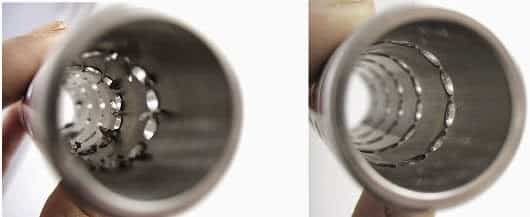Cross-hole deburring removes the burrs that are created when manufacturers and machinists cross-drill intersecting holes on metal parts. Removing these ragged edges, raised areas, particles, protrusions, and shavings improves part function and quality. Because metal burrs can cause part misalignments, cross-hole deburrring supports the smooth operation of machinery and mechanical systems. Burr removal also promotes plant safety and production efficiency. Operators who handle machined parts or blanks with burrs risk injury, and poor surface finish quality on machine components can impede production. What’s the best way to remove burrs from cross-drilled holes then? First, you’ll need to select the right tool for the job. Next, you’ll need to follow suggested operating parameters and best practices.
Choose the Right Cross-Hole Deburring Tool for the Job
The Flex-Hone® tool from Brush Research Manufacturing (BRM) is a flexible, resilient honing tool that removes burrs from cross-drilled holes and improves surface finish at the same time. Known also as a ball hone, the BRM Flex-Hone® features abrasive globules that are permanently laminated to flexible nylon filaments. These abrasive globules or balls provide a soft cutting action that removes burrs from cylinder walls while leaving the base metal undisturbed.
BRM supplies Flex-Hone® tools in 8 different abrasive types and 11 different options in diameters from 4-mm to 36” for use with a wide variety of base materials and surface finish requirements. The Flex-Hone® Resource Guide explains how to select the right cross-hole deburring tool for your application, and also provides suggested operating parameters. Flexible honing does not require specialized training, but it’s important to follow best practices for optimal results.
Follow Best Practices for Deburring Cross-Drilled Holes
Flexible hones have a wire stem for use with most any rotating spindle. With CNC equipment, the tool is secured with a Jacobs-style collet that’s clamped directly to the stem wire. BRM’s cross-hole deburring tools are used also in lathes, mills, drill presses, and electric hand drills.
When deburring cross-drilled holes with the Flex-Hone®, BRM recommends that you first stroke and rotate the tool in a clockwise direction. Then remove the cylinder hone from the bore, reverse the spindle, and stroke and rotate in a clockwise direction. This promotes a more symmetrical deburring pattern and prevents the burr from folding back into the cross-hole. During cross-hole deburring, and with any Flex-Hone® operation (such as cylinder wall deglazing), always use a lubricant or good-quality honing oil. This prevents tool loading, and ensures the exposure of fresh cutting particles.

